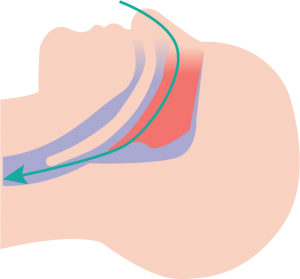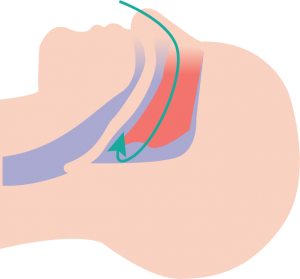OBSTRUCTIVE SLEEP APNEA

Normal airway

Airway obstructed by apnea
What is Obstructive Sleep Apnea?
You likely know someone who snores – maybe even you! The sound of snoring is made from relaxed tissues vibrating in the airway as one breathes at night. As the tissues relax in the airway, they can begin to obstruct the movement of air, which causes snoring. If the obstruction becomes bad enough, the air cannot pass through the airway resulting in an apnea or lack of breathing. This causes a drop in the blood oxygen level, places stress on the heart, and can disrupt sleep.
What are Symptoms of Obstructive Sleep Apnea (OSA)?
Snoring is the easiest and most obvious way to determine if the airway is obstructed while you sleep but not everyone who snores has sleep apnea. Other symptoms of OSA include difficulty staying asleep at night, pauses in breathing or waking up gasping or snorting, feeling unrefreshed in the morning, sleepiness during the day, morning headaches and dry mouth, depression, irritability, sexual dysfunction, difficulty concentrating and memory issues.
How Common is OSA?
OSA is estimated to affect at least 26% of the adult population aged 30-70 years, and the prevalence increases with age. OSA is less common in children, with 1-5% of children being diagnosed with OSA.
What Happens if OSA is Left Untreated?
Although not all individuals with OSA experience problematic symptoms, some may experience significant daytime sleepiness and other symptoms listed above as well as decreased performance at work and school.
Moderate to severe OSA is associated with a higher risk of cardiovascular and cerebrovascular disease such as high blood pressure, heart disease, and stroke. The presence of OSA can make it more difficult to manage diabetes and mental health issues. Cognitive abilities (memory, reasoning, problem solving, comprehension, etc.) may be impaired.
OSA has also been found to be associated with a higher risk of Alzheimer’s disease, glaucoma, falls resulting in injury, impaired quality of life, decreased tolerance of pain, and increased frailty and mortality.
How Can I Treat OSA?
CPAP – Continuous Positive Airway Pressure is a type of therapy where pressurized air from a device holds your airway open, so relaxed tissue cannot block the movement of air. It involves wearing a mask while you sleep. This mask may cover your nose or both your nose and mouth. CPAP is considered the most effective form of treatment.
Oral Sleep Appliances – These are devices that can be made by a dentist to move the lower jaw forward while you sleep. By increasing the amount of space in the airway, the obstruction in the airway can be reduced.
Nerve Stimulators – This therapy involves the implantation of a device that delivers a small amount of electricity to the base of the tongue. The tongue stiffens much like a flexed muscle and moves slightly forward. This can reduce the amount of obstruction in the airway as well.
Lifestyle Changes – While these may not eliminate OSA entirely, lifestyle changes can reduce severity and help with symptoms. These changes include losing weight, avoiding alcohol, quitting smoking, and avoiding sleeping on the back.



Take the “4 Week Sleep Challenge” to learn more about your sleep pattern.
The better your sleep habits, the better you’ll feel!
